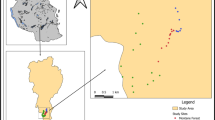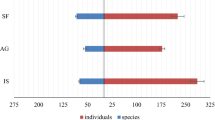Abstract
Habitat degradation poses a great threat to biodiversity conservation. Abundance and diversity of butterflies is an indicator of good environmental health. Understanding how different butterfly species respond to habitat degradation is a necessary step towards the development of effective measures to enhance environmental protection. This study investigated the impact of land use patterns on the diversity, abundance, and conservation status of butterflies in the Kisii highlands; a densely-populated region in Kenya that has received little attention in ecological studies. Sampling was done through a line transect of 300 m. A total of 2799 individual butterflies comprising 67 species were recorded across seven land cover types; secondary forest, grasslands, riverine, human settlement, mixed farmlands, monoculture, and mining areas. The secondary forest, riverine and mixed farmlands recorded more butterflies (37.0, 26.0, and 15.5 %, respectively), followed by grasslands (12.5 %), while monoculture, human settlements, and mines had the least number of butterflies (3.0 % each). Moreover, the secondary forest, riverine and mixed farmland land cover types were the most species rich. Nymphalidae were the most abundant (38 species) whereas, Papilionidae the least (3 species) in the region. Junonia sophia was the dominant species. Butterflies were most diverse in the secondary forest (Shannon–Weaver diversity index, H′ = 2.89), while the human settlement had the least (H′ = 1.25). One-way ANOVA analysis indicated a higher species similarity between secondary forest, mixed farming and riverine land cover types compared to a low species similarity between secondary forest and mining, grassland, monoculture and human settlement. Butterfly abundance and distribution was different between the dry and wet season among the land cover types. Therefore, land use patterns had effects on butterfly abundance and diversity and their conservation is threatened if proper management practices are not put in place. Planning of land use activities should thus encourage agro-forests/secondary forests interspaced with other land use activities to enhance environmental health and improve on biodiversity conservation.


Similar content being viewed by others
References
Akite P (2008) Effects of anthropogenic disturbances on the diversity and composition of the butterfly fauna of sites in the Sango Bay and Iriiri areas, Uganda: implications for conservation. Afr J Ecol 46:3–13
Borghesio L (2008) Effects of human subsistence activities on forest birds in Northern Kenya. Conserv Biol 22(2):384–394
Buschini MLT, Woiski TD (2008) Alpha-beta diversity in trap-nesting wasps (Hymenoptera: aculeata) in Southern Brazil. Acta Zool 89(4):351–358
Caldas A, Robbins RK (2003) Modified pollard transects for assessing tropical butterfly abundance and diversity. Biol Conserv 110:211–219
Chazdon RL, Peres CA, Dent D, Sheil D, Lugo AE, Lamb D, Stork NE, Miller S (2009) The potential for species conservation in tropical secondary forests. Conserv Biol. doi:10.1111/j.1523-1739.2009.01338.x
Clarke KR, Warwick RM (2001) A further biodiversity index applicable to species lists: variation in taxonomic distinctness. Mar Ecol Prog Ser 216:265–278
Critical Ecosystem Partnership Fund (2005) Eastern arc mountains and coastal forests of Tanzania and Kenya. ICIPE, Kenya
D’Abrera B (2001) Butterflies of the Afrotropical region. Melbourne, Australia
Dale VH, Beyler SC (2001) Challenges in the development and use of ecological indicators. Ecol Indic 1:3–10
DeVries PJ (1987) Ecological aspects of ant association and host plant use in a riodinid butterfly. Ph.D. Dissertation, University of Texas, Austin, USA
Dunn RR (2005) Modern insect extinctions, the neglect majority. Conserv Biol 19:1030–1036
Fitzherbert E, Gardner T, Davenport TRB, Caro T (2006) Butterfly species richness and abundance in the Katavi ecosystem of Western Tanzania. Afr J Ecol 44(3):353–362
Fox R (2013) The decline of moths in Great Britain: a review of possible causes. Insect Conserv Diver 6(1):5–19
Franzén M, Nilsson SG, Johansson V, Ranius T (2013) Population fluctuations and synchrony of grassland butterflies in relation to species traits. PLoS One 8(10):e78233. doi:10.1371/journal.pone.0078233
Hecq J (2002) Euriphene. In: Bauer E, Frankenbach T (eds) Butterflies of the world, Part 15, Nymphalidae VI. Goeke and Evers, Keltern, Germany
Hole DG, Huntley B, Arinaitwe J, Butchart SHM, Collingham YC, Fishpool LDC, Pain DJ, Willis SG (2011) Toward a management framework for networks of protected areas in the face of climate change. Conserv Biol 25(2):305–315
Hughes JB, Daily GC, Ehrlich PR (2002) Conservation of tropical forest birds in countryside habitats. J Ecol 5:121–129
Kenya National Bureau of Statistics (2009) Population and Housing census 2009. Nairobi, Kenya
Kisii County Government (2013) The first county integrated development plan 2013–2017. Kisii, Kenya
Kremen C (1992) Assessing the indicator properties of species assemblages for natural areas monitoring. Ecol Applic 2(2):203–217
Larsen TB (1996) The Butterflies of Kenya and their natural history. Oxford University Press, Oxford
Larsen TB (2005) Butterflies of West Africa. Apollo books, Svendborg, Denmark 1–595, 1–270
Laurance WF, Useche DC, Rendeiro J et al (2012) Averting biodiversity collapse in tropical forest protected areas. Nature 489:290–294
Lee TM, Jetz W (2008) Future battlegrounds for conservation under global change. Proc R Soc 275:1261–1270
Liley D, Brereton T, Roy D (2004) The current level of butterfly monitoring in UK woodlands. Report to the forestry commission, Report No. SO4–35
Milder JC, Scherr SJ, Bracer C (2010) Trends and future potential of payment for ecosystem services to alleviate rural poverty in developing countries. Ecol Soc 15(2):4
Millennium Ecosystem Assessment (2005) Ecosystem and human well-being: biodiversity synthesis. Island press, Washington
Munyuli MBT (2012) Butterfly diversity from Farmlands of Central Uganda. Hindawi Publishing Corporation 2012:481509
Murphy DD, Freas KE, Weiss SB (1990) An environment-metapopulation approach to population viability analysis for a threatened invertebrate. Conserv Biol 4:41–51
Namu NF (2005) Effects of forest disturbances on butterfly diversity in Kakamega Forest National Reserve (K. F.H.R.) Western, Kenya. M. Sc. Thesis, University of Nairobi, Kenya
Namu FN, Githaiga JM, Kioko EN, Ndegwa PN, Hauser CL (2008) Butterfly species, composition, and abundance in an old, middle-aged, and young secondary forest. In: Kuhne L (ed) Butterflies and moth diversity of Kakamega Forest (Kenya). Brandenburgische Universitätsdruckerei und Verlagsgesellschaft, Germany, pp 47–61
Ngongolo K, Mtoko S (2013) Using butterflies to measure biodiversity health in Wazo hill restored quarry. Entomol Zool Stud 1(4):81–86
Nyamweya NH, Gichuki NN (2010) Effects of plant structure on butterfly diversity in Mt. Marsabit forest—Northern Kenya. Afric J Ecol 48:304–312
Palmer AR (1994) Fluctuating asymmetry analyses: a primer. In: Markow TA (ed) Developmental instability: its origins and evolutionary implications. Kluwer Academic Publishers, Dordrecht, pp 335–364
Pimm SL, Raven P (2000) Biodiversity: extinction by numbers. Nature 403:843–845
Pollard E, Yates TG (1993) Monitoring butterflies for ecology and conservation, vol 1. Chapman and Hall, London
Raina SK, Kioko E, Zethner O, Wren S (2011) Forest habitat conservation in Africa using commercially important insects. Annu Rev Entomol 56:465–485
Ramesh T, Hussain JK, Selvanayagam M, Satpathy KK, Prasad MVR (2010) Patterns of diversity, abundance and habitat associations of butterfly communities in heterogeneous landscapes of the department of atomic energy (DAE) campus at Kalpakkam South India. Int J Biodiver Conserv 2(4):75–85
Rodríguez JP, Rodríguez-Clark KM, Baille JEM et al (2010) Establishing IUCN red list criteria for threatened ecosystems. Conserv Biol 25(1):21–29
Sala OE, Chapin FS III, Armesto JJ et al (2000) Global biodiversity scenarios for the year 2100. Science 287:1770–1774
Scherr SJ, McNeely JA (2008) Biodiversity conservation and agricultural sustainability: towards a new paradigm of ‘ecoagriculture’ landscapes. Phil Trans R Soc B 363:477–494
Shannon CF, Weaver W (1949) The Mathematical theory of communication. University of Illinois Press, Urbana
Simpson EH (1949) Measurement of diversity. Nature 163:688
Spitzer K, Joras J, Havelka J (1997) Effects of Small-scale disturbance on butterfly communities of an Indochinese montane rainforest. Biol Conserv 80:9–15
Tiple AD, Khurad AM, Dennis RLH (2007) Butterfly diversity in relation to a human-impact gradient on an Indian university campus. Nota Lepidopteral 30(1):179–188
Waltert M, Mardiastuti A, Muhlenberg M (2004) Effects of land use on bird species richness in Sulawesi, Indonesia. Conserv Biol 18:1339–1346
Waltert M, Bobo KS, Sainge MN, Fermon H, Muhlenberg M (2005) From forest to farmland: habitat effects on Afrotropical forest bird diversity. Ecol Appl 15:1351–1366
Western D, Russell S, Cuthill I (2009) The status of wildlife in protected areas compared to non-protected areas of Kenya. PLoS One 4(7):e6140
Acknowledgments
We thank Dr. Esther Kioko and Mr. Mugambi of the National Museums of Kenya for their assistance in the identification of butterflies and for their helpful discussions and comments.
Author information
Authors and Affiliations
Corresponding author
Electronic supplementary material
Below is the link to the electronic supplementary material.
Rights and permissions
About this article
Cite this article
Sagwe, R.N., Muya, S.M. & Maranga, R. Effects of land use patterns on the diversity and conservation status of butterflies in Kisii highlands, Kenya. J Insect Conserv 19, 1119–1127 (2015). https://doi.org/10.1007/s10841-015-9826-x
Received:
Accepted:
Published:
Issue Date:
DOI: https://doi.org/10.1007/s10841-015-9826-x




